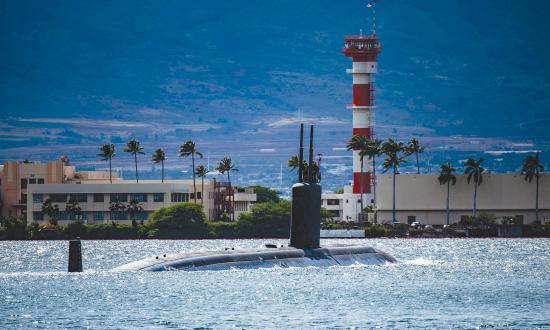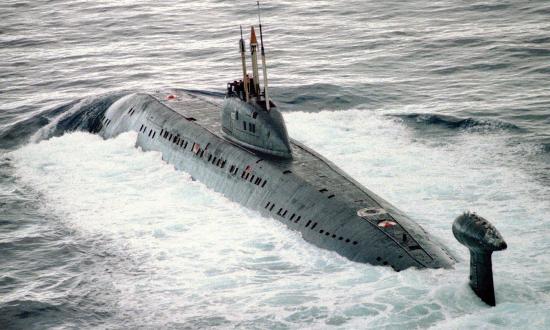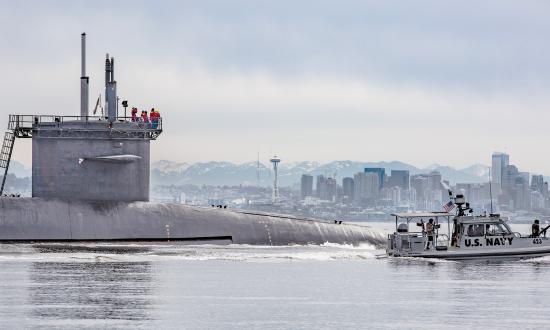The submarine force is one of the most significant advantages the U.S. Navy enjoys over its competitors. This is not by accident. It comes from unique factors that set our force apart, that make it lethal and fearsome, and that we must work diligently to preserve: self-sufficiency, a culture of self-assessment and problem resolution, a warrior ethos, and outstanding people.
Self-Sufficiency
Empowered with a skillfully designed nuclear power plant and an unmatched mission command structure, submarines can get to the fight quickly and deliver devastating impact to an enemy. The reactor underpins our submarines’ self-sufficiency—allowing them to deploy quickly across the globe and remain on station almost indefinitely with minimal support. Nuclear power means our primary limiting factor is not fuel, but rather “beans and bullets”—inventories we are improving. In the “beans” category, we deploy submarines with larger stores loadouts, freeze-dried foods, and innovative menus. As far as “bullets” go, we are improving our weapons inventory with new designs, including the Virginia Payload Module, able to carry an additional 28 missiles.
Mission command enables submarine self-sufficiency. At sea, submarine commanders routinely confront major operational, engineering, and personnel problems; decide on courses of action; and execute their plans without consulting their chains of command, sometimes not even informing them until weeks later. They are trained to operate independently, to know that they can always ask for help if needed, and to overcome challenges to execute commander’s intent. The captain and crew of the USS Newport News (SSN-750) personified this self-sufficiency during a recent extended deployment, which included an unprecedented 137 straight days at sea.1 While most ships and aircraft are continuously connected by advanced communications and command-and-control structures, submarines often have to operate for days or weeks without communications with higher headquarters.
A Culture of Self-Assessment and Problem Resolution
Hand-in-hand with Naval Reactors, the submarine force has developed a culture that encourages and expects everyone to assess their ships, shipmates, and themselves. From junior watchstanders in the engine room to the captain on the conn, submariners ask questions, challenge assumptions, and uncover problems. When they find problems, our officers and sailors are instilled with a desire to attack them relentlessly until they are solved.
Recently a group of junior officers (JOs) realized the submarine force was failing to capitalize on opportunities presented by artificial intelligence and machine learning (AI/ML). They conducted their own research and algorithm development, gained partners within the military and industry, and initiated “Project Harbinger.”2 Because of their drive and creativity, we have brought the resources of the entire undersea enterprise to bear on the problem through Task Force TURING, a new submarine force organization linking operational, technical, and acquisition commands to harness the scalable power of AI/ML.
Every organization suffers from mishaps, failures, and flaws, and the submarine force is no different. What provides an advantage, however, is submariners’ willingness to admit problems, determination to find them, and drive to solve them.
Warrior Ethos
During World War II, destroyers’ sensors, speed, and weapons made them fierce adversaries that submarines tended to avoid. However, Commander Samuel D. Dealey and his crew on the USS Harder (SS-257) did just the opposite. Already credited with sinking numerous enemy ships, on his fifth war patrol, Dealey conducted brazen “down-the-throat” torpedo attacks, sinking five destroyers in short-range fights that earned him the Medal of Honor and the crew of the Harder a Presidential Unit Citation.3
Dealey exhibited the submarine force’s most palpable edge, our warrior ethos, a spirit we honor and carry on today. Our officers and sailors cannot earn their dolphins, the original Navy warfare pin, without knowing the names of our World War II heroes, including Dick O’Kane, Lawson “Red” Ramage, and Eugene Fluckey. Earning their dolphins requires being able to combat casualties to keep their ship in the fight—exhibiting the grit, tenacity, and innovation needed to take a punch, get back up, and succeed in battle.
Outstanding People
Since 2015, 42 percent of the Navy’s prestigious Vice Admiral James Stockdale Leadership Awards have gone to submarine officers, despite the fact that they account for only 14 percent of the Navy’s unrestricted line officers. We have numerous pioneers, such as Chief Dominique Saavedra, who became the first woman to earn silver dolphins in 2016, forging the way for an increasing number of women in the force. As an ensign, Commander Joel Holwitt published ‘Execute against Japan’, a book the Chief of Naval Operations (CNO) selected for the Navy Professional Reading Program. More recently, Joel won the CNO Naval History Essay Contest in 2017 and 2019, and he is in the command pipeline now.
With a workforce of smart, diligent professionals, we face a lot of competition for their talents. During the past five years, we have struggled to meet JO retention goals, reducing flexibility in department head manning and shrinking the pool of officers available for command. To address retention, we solicited extensive JO feedback. Learning from them, we changed the detailing process to better reward performance, offered improved career path flexibility, and implemented talent management boards to increase selection for graduate education programs and unique career-broadening experiences. My fellow submarine flag officers and I are interacting with JOs to understand their concerns and to highlight the benefits of a career in our force. These initiatives are a start, but we need all submarine commanding officers (COs) to prioritize solving the retention problem, as they have the most direct impact on developing and retaining our next generation of leaders.
Part of the solution to JO retention will be continued expansion of opportunities for women in the force. Since the first women submariners joined our fleet in 2010, they have excelled in every facet of our profession. For example, 23 percent of the 2019 submarine force Junior Officers of the Year were women, despite comprising 6 percent of our wardrooms. Today, there are 100 female officers and more than 230 female sailors serving on 19 submarine crews, and 6 women lieutenant commanders have screened for submarine executive officer. We are incorporating women into the force as rapidly as we can, making sure we understand retention trends and impacts on community staffing at all levels as we integrate more crews, submarines, and homeports.
Another aspect of retaining the best people is highlighting their best ideas and putting them to work. In addition to increased educational opportunities, the recent NavAdmin message 137/20 lifts “education to a strategic priority alongside our platforms and weapons systems” and notes that reporting seniors must document in fitness reports “participation in discussion groups and military societies” and “publishing in national security or military journals.” To this end, I urge submariners at all ranks to become members of professional organizations and to “read, think, speak, and write” to make our force and our Navy better.
Preserving the Edge
It is one thing to develop a competitive advantage; it is another thing altogether to preserve it year after year. Our competitors strive to match our edge in design, construction, tactics, and training, while challenges internal to our force have reduced the number of operationally available submarines ready for combat.
Abroad, the Russian Navy is deploying increasingly impressive submarines. As Admiral James G. Foggo wrote when he commanded the Sixth Fleet, Russia is fielding new submarines that are “much stealthier, carry more devastating weaponry, and go on more frequent and longer deployments” than during the Cold War.4 Meanwhile, China continues to prioritize the expansion and modernization of its submarine force. With both nuclear and conventionally powered submarines, the People’s Liberation Army Navy has more attack submarines today than the U.S. Navy.5 Rogue nations have their own undersea presence; for example, North Korea is working to develop its own ballistic-missile submarine.6
These competitors drive us to improve every day. The submarine force recently conducted a holistic review of its ability to prevail in battle. This led to numerous improvements, such as reframing our tactical readiness evaluation to focus on combat, renewing our emphasis on innovative tactical development exercises, and instituting “Fight Clubs” to pit submarine crews against each other in competitive warfighting scenarios.
We are constantly seeking ways to make our submarines quieter. To this end, the Navy recently commissioned the USS South Dakota (SSN-790), the first Virginia-class submarine with the new acoustic superiority package, which features a large vertical array, a special coating, and advanced quieting measures. As Admiral Chas Richard said when he served as the Director of Undersea Warfare, “We’re not taking our stealth for granted, and we’re not taking this competitive advantage we have for granted.”7
Beyond improving our own submarines, we also are strengthening our bonds with allies and partners. The Diesel-Electric Submarine Initiative (DESI), for example, is a partnership between the U.S. Navy and four very capable South American navies (Peru, Colombia, Chile, and Brazil) that fosters trust, enables interoperability, and gives us experience with nonnuclear submarines. In July, I participated in the Fourth Battle of the Atlantic Exercise, which involved 30 commands, including the United Kingdom Strike Force, French Maritime Forces Atlantic, Norwegian Joint Headquarters, and the Danish Joint Operations Center.8
In the long term, we are focusing efforts on the Future Undersea Warfighting Concept. This document describes a warfighting concept and operational framework for how future undersea forces will be used to deter aggression and win conflicts. It provides guidance for the entire undersea enterprise—operators, program managers, the defense industry, and acquisition experts—and it will be instrumental in the development of the next class of attack submarines, weapons, unmanned platforms, sensors, and networks.
Overcoming Shipyard Challenges and Delivering the Future Force
As we work to stay ahead of our competitors, we must overcome internal challenges that threaten our progress. First, we must improve the execution of large shipyard maintenance periods. Between 2008 and 2018, attack submarines incurred more than 10,000 days of idle-time delays waiting for other ships to complete their availabilities, a problem that is increasing in severity today.9 This places more demands on the operational fleet, while reducing the number of submarines available to forward commanders. The USS Boise (SSN-764), for example, was idle for four years while waiting for an available dry dock. This is unacceptable. We simply cannot have submarines waiting on other submarines that are on the blocks in delayed maintenance periods.
This problem is our number one challenge, and we are attacking it head-on. Initiatives such as “Performance to Plan” analytically dissect our work to identify and fix inefficiencies. We are reconstituting Submarine Squadrons Two and Eight at Portsmouth Naval Shipyard and in Norfolk, Virginia, respectively, to focus solely on units in the shipyards and assist their transition back to the fleet. Finally, we have a path forward for the Boise, which is now progressing through its maintenance package. In the future, the force needs to work more closely with private shipyards to alleviate the burden on oversubscribed government yards.
In addition, we must deliver the Columbia-class ballistic-missile submarines (SSBNs) on time. Since 1960, our SSBNs have helped to deter strategic attacks on the homeland and to limit wars to regional conflicts. This is a no-fail mission that would be disrupted if the Columbia class were to arrive late, and there is no margin of error between when the Ohio class starts to retire and the Columbia-class submarines start to arrive. The entire class must meet construction and delivery schedules to ensure required strategic deterrence coverage. We must prepare the dry docks, pier facilities, training centers, and workforce for this new class of ship.
To meet this expectation, Chief of Naval Operations Admiral Mike Gilday has made recapitalizing the strategic nuclear deterrent the Navy’s “first acquisition priority.”10 By dispatching inspection teams to suppliers to ensure first-time quality, learning from years of testing on land-based prototypes, and shifting shipyard resources to mitigate the effects of COVID-19, we will execute the first Columbia patrol in fiscal year 2031, as planned.
Commander’s Intent 3.0
Preserving the combat edge of the submarine force is my primary objective. Constantly honing our edge ensures combatant commanders in every theater can confidently apply submarine assets to their most complex problems and enhance their combat power. Rear Admiral Blake Converse, Commander, Submarine Forces Pacific, and I have just signed “Commander’s Intent 3.0,” which lays out our priorities and how we will achieve them and defines our expectations for all members of the force. It is an unclassified document that I encourage all to read. It has ten classified annexes covering campaign plans and outlines three key goals:
Enhance Strategic Deterrence. The submarine force will maintain a credible nuclear deterrent through its SSBN force, which provides the only survivable leg of the nation’s strategic deterrent triad and carries approximately 70 percent of the nation’s accountable nuclear warheads.
Integrate Combat Power with the Joint Force. The days of submarines conducting autonomous war patrols are over. We will use our unique capabilities to coordinate, integrate, and operate closely with Navy and joint partners, in missions that include passing targeting data to distant missile shooters, inserting special operations forces in denied locations, and more.
Enable All-Domain Maneuver Warfare. Our adversaries will seek to deny our fleet access during major combat operations. The primary task of the submarine force will be to use its stealth and self-sufficiency to penetrate those areas, wreak havoc, and pave the way for the rest of the Navy and joint force to maneuver and fight with confidence.
When Navy and Department of Defense leaders speak of the submarine force’s competitive advantage, they also warn that it cannot be taken for granted. As former CNO Admiral Jonathan Greenert wrote, the undersea is “the one domain in which the United States has clear maritime superiority—but this superiority will not go unchallenged.”11 Each day, we must heed those warnings and work to protect, preserve, and increase our edge to ensure the nation can rely on the Navy’s advantage in the undersea.
1. Holly Carey, “USS Newport News Returns from Deployment,” 20 July 2020, www.navy.mil/Press-Office/News-Stories/display-news/Article/2287363/uss-newport-news-returns-from-deployment.
2. CDR Bennett Christman and LCDR Ryan Hilger, “Strategic Innovation from the Deckplate,” Undersea Magazine, October 2019, www.public.navy.mil/subfor/underseawarfaremagazine/Issues/PDF/USW_Summer_2019.pdf.
3. www.navalsubleague.org/links/historymuseums/submarine-force-medal-honor-recipients/cdr-samuel-d-dealey-1944/
4. VADM James Foggo III, USN, and Alarik Fritz, “The Fourth Battle of the Atlantic,” U.S. Naval Institute Proceedings 142, no. 6 (June 2016), www.usni.org/magazines/proceedings/2016/june/fourth-battle-atlantic.
5. U.S. Department of Defense, Annual Report to Congress: Military and Security Developments Involving the People’s Republic of China 2019 (Washington, DC: Office of the Secretary of Defense, 2019), 35.
6. Jon Herskovitz and Adrian Leung, “How a North Korean Nuclear-Armed Submarine Could Make It Even Harder to Strike a Deal,” Time, 4 February 2020, https://time.com/5778066/north-korea-nuclear-submarine/.
7. Megan Eckstein, “Submarines to Become Stealthier through Acoustic Superiority Upgrades, Operational Concepts,” USNI News, 28 March 2016, https://news.usni.org/2016/03/28/submarines-to-become-stealthier-through-acoustic-superiority-upgrades-operational-concepts.
8. “Trans-Atlantic Leaders Gather for Fourth Battle of the Atlantic Tabletop Exercise,” Defense Visual Information Distribution Service, 1 July 2020, www.dvidshub.net/news/373268/trans-atlantic-leaders-gather-fourth-battle-atlantic-tabletop-exercise.
9. U.S. Government Accountability Office, Actions Needed to Address Costly Maintenance Delays Facing the Attack Submarine Fleet (Washington, DC: Government Accountability Office, November 2018), 7.
10. Chief of Naval Operations, FRAGO 0/2019: A Design for Maintaining Maritime Superiority (Washington, DC: Department of the Navy, December 2019), 6.
11. “CNO: New Sub-Hunting Capabilities Challenge U.S. Undersea Dominance,” Inside the Pentagon, 28, no. 41 (11 October 2012): 1.








